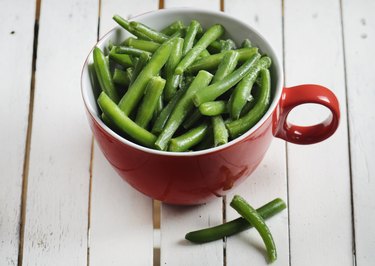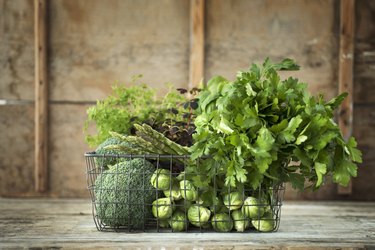
When doing some quick converting in the kitchen, it's handy to know exactly how many ounces are in a serving. Generally, you can start with the fact that 1 cup equals 8 ounces.
Pretty straightforward, right? But things get trickier when you're trying to measure out foods of widely varying shapes and sizes, such as vegetables.
Video of the Day
Video of the Day
It's one thing to know the number of servings you need in a day, but it's also helpful to know different measurements for dry ingredients (like veggies) and how they convert.
Measurement Conversions to Know
- 1 cup = 8 ounces
- 1 pint = 2 cups
- 1 quart = 2 pints
- 1 gallon = 4 quarts
Vegetable Serving Sizes
Vegetables are essential for your diet, giving you an abundance of vitamins, minerals and fiber. So you want to make sure you're eating enough.
In general, one cup of raw or cooked vegetables or vegetable juice (eight ounces) or two cups of raw leafy greens (16 ounces) can be considered as one serving from the vegetable group.
The number of servings of vegetables you need depends on your age and sex assigned at birth, according to the USDA.
Sex Assigned at Birth | Age | Cups of Daily Veggies | Ounces of Daily Veggies |
|---|---|---|---|
Female | 19 to 30 | 2 1/2 to 3 cups | 20 to 24 |
Male | 19 to 59 | 3 to 4 | 24 to 32 |
Female | 30+ | 2 to 3 | 16 to 24 |
Male | 60+ | 2 1/2 to 3 1/2 | 20 to 28 |
Related Reading
A Serving of Non-Starchy Vegetables
While all veggies are beneficial, if you're watching your weight, you may want to opt for non-starchy types and leafy greens because they have about a third of the calories of starchy vegetables and are lower in carbohydrates.
Non-starchy vegetables include:
- Leafy greens
- Broccoli
- Carrots
- Peppers
- Mushrooms
- Asparagus
- Cucumbers
- Eggplant

A Serving of Leafy Greens
Leafy greens are part of the non-starchy veggie group, but they can be tricky to measure. If you chop up lettuce and fill up a 1-cup dry measuring cup twice, which is 16 ounces in all, you'll get your single serving.
Some examples of leafy greens are:
- Bibb lettuce
- Arugula
- Romaine
- Iceberg
- Watercress
- Green and red leaf lettuce
- Spinach
- Endive
- Escarole
If you like a steamed side of those dark leafy greens, such as collard greens, kale or Swiss chard, a single serving of steamed leafy greens is equal to a 1/2 cup of the cooked vegetable, or 4 ounces.
Related Reading
A Serving of Starchy Vegetables
Starchy vegetables can certainly fit into your balanced diet, but be aware that a single serving has more calories and carbohydrates than non-starchy varieties. As with non-starchy vegetables, one serving of starchy vegetables means 1 cup or 8 ounces.
Some examples of starchy vegetables are:
- White potatoes, diced or mashed
- Bean sprouts
- Cabbage, green
- Cauliflower
- Celery
- Cucumbers
- Corn, yellow or white (one large ear)
- Green peas
- Parsnips
- Pumpkin
- Squash, acorn and butternut

Tips to Help You Eat More Veggies
If you're struggling to meet the daily recommendation for vegetables, you might be wondering if there are some easy ways to fit more veggies into your diet.
The good news is there are unlimited options when it comes to sneaking a cup of leafy greens or raw veggies into your meals.
- Make a dinner that includes a vegetable main dish, such as a vegetable stir-fry or soup.
- Shred carrots or zucchini into meatloaf, casseroles and muffins.
- Make a smoothie with fruit and vegetables like carrots, spinach, kale or beets.
- Include chopped vegetables in pasta sauce or lasagna.
- Order a veggie pizza with toppings like mushrooms, green peppers and onions, and ask for extra veggies.
- Grill vegetable kabobs as part of a barbecue meal with tomatoes, mushrooms, green peppers and onions.
- Serve a vegetable platter with your favorite dip as a side dish with lunch or dinner.
- Make vegetable-based soups like carrot soup, pumpkin soup or broccoli cheddar soup.
- Make spaghetti with zucchini noodles.
- Make a cauliflower pizza crust.
- Add vegetables to your omelet or scrambled eggs in the morning.
- Use lettuce or collards as a wrap in place of a bun or bread for your burger or sandwich.
Related Reading